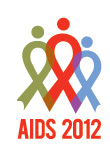 Black HIV-positive men who have sex with men are less likely to be receiving antiretroviral therapy and to have undetectable viral loads, observations by the U.S. Centers for Disease Control and Prevention (CDC) that may help explain why the infection rate continues unabated among gay and bisexual men of color.
Black HIV-positive men who have sex with men are less likely to be receiving antiretroviral therapy and to have undetectable viral loads, observations by the U.S. Centers for Disease Control and Prevention (CDC) that may help explain why the infection rate continues unabated among gay and bisexual men of color.
“Over half of sexually active black men who have sex with men (MSM) are not durably virally suppressed, and this may be contributing to disparities in HIV incidence between black and white MSM,” explained Linda Beer, PhD, of the CDC, while presenting her team’s study findings on Monday, July 23, at the XIX International AIDS Conference (AIDS 2012) in Washington, DC.
Her group’s findings jive with other reports at the conference, including an analysis of multiple studies linking the high infection rates among black MSM not to higher rates of risky sexual behavior but to key structural inefficiencies, along with another study exploring viral suppression rates and transmission risk among gay and bisexual men.
Beer and her colleagues were reporting the first nationally representative data on disparities in antiretroviral (ARV) use and viral suppression among sexually active black and white MSM who are receiving care for HIV. Their analysis included 4,217 participants—314 black MSM and 696 whit MSM—from 461 HIV care facilities across the U.S.
There were statistically significant differences—chasms that were too great to have occurred by chance—in important clinical factors between the two groups, Beer reported. While almost three of four white MSM had durably suppressed viral loads—a hallmark sign of being much less likely to transmit the virus, even if sex without condoms occurs—the same was true for only about half of black MSM.
“This could account for higher HIV incidence among black MSM,” Beer said. “Black MSM were less likely to be on ARV therapy, which is the path to viral suppression.” According to her group’s analysis, black MSM were 7 percent less likely than white MSM to be taking ARVs. “In terms of viral suppression,” she said, “even limiting our analysis to those who were on ARVs, black MSM were 8 percent less likely to be durably suppressed.”
How to explain these differences? Beer pointed out that the black MSM were, on average, younger and more recently diagnosed with HIV, both of which have been associated with a lower likelihood of viral suppression. In addition, she said, black MSM are less likely than their white peers to have access to resources that support health, such as health care, income and education. “Even adjusting for these,” she said, “we still saw a lower probability that black MSM would achieve durable viral suppression. Other contributing factors could include differences in adherence or differences in ARV regimens,” and she said the ongoing study would look into both those areas.
Because it encompassed only people in care, Beer suggested that the racial differences seen in the study are probably less severe than what would be seen in a review of the entire HIV-positive MSM population. “Many studies have found that [HIV-positive] African Americans are less likely than whites to link to and be retained in care,” she explained.
“The majority of HIV-positive MSM in care were on ARVs and virally suppressed, so that is good news,” Beer said in concluding her presentation. “However, over half of sexually active black MSM are not durably virally suppressed, and this may be contributing to disparities in incidence. The effect of even small differences can be compounded by relatively closed sexual networks and socio-demographic factors more prevalent among black MSM.”
Advertisement
Advertisement
Advertisement






Comments
Comments